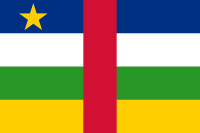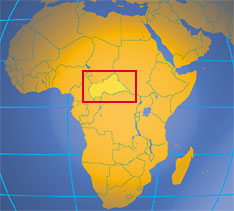 The Central African Republic (CAR) (French: République centrafricaine, pronounced: [ʁepyblik sɑ̃tʁafʁikɛn], or Centrafrique [sɑ̃tʀafʀik]; Sango Ködörösêse tî Bêafrîka), is a landlocked country in Central Africa. It borders Chad in the north, Sudan in the east, the Democratic Republic of the Congo and the Republic of the Congo in the south, and Cameroon in the west. The CAR covers a land area of almost 623,000 km², and has an estimated population of about 4.4 million as per 2008. Bangui is the capital city.
The Central African Republic (CAR) (French: République centrafricaine, pronounced: [ʁepyblik sɑ̃tʁafʁikɛn], or Centrafrique [sɑ̃tʀafʀik]; Sango Ködörösêse tî Bêafrîka), is a landlocked country in Central Africa. It borders Chad in the north, Sudan in the east, the Democratic Republic of the Congo and the Republic of the Congo in the south, and Cameroon in the west. The CAR covers a land area of almost 623,000 km², and has an estimated population of about 4.4 million as per 2008. Bangui is the capital city.
Most of the CAR consists of Sudano-Guinean savannas but it also includes a Sahelo-Sudanianzone in the north and an equatorial forest zone in the south. Two thirds of the country lies in the basins of the Ubangi River, which flows south into the Congo River, while the remaining third lies in the basin of the Chari River, which flows north into Lake Chad.
The Central African Republic is governed under the constitution of 2004. The president, who is the head of state, is popularly elected for a five-year term and is eligible for a second term. The government is headed by a prime minister, who is appointed by the political party with a parliamentary majority. The unicameral legislature consists of the 109-seat National Assembly, whose members are popularly elected for five-year terms. Administratively, the country is divided into 14 prefectures, two economic prefectures, and the Bangui federal district.
Since most of the territory locates in the Ubangi and Shari river basins, France called the colony it carved out in this region Ubangi-Chari, or Oubangui-Chari in French. It became a semi-autonomous territory of the French Community in 1958 and then an independent nation on 13 August 1960. For over three decades after independence, the CAR was ruled by presidents who were not chosen in multi-party democratic elections or took power by force. Local discontent with this system was eventually reinforced by international pressure, following the end of theCold War.
The first multi-party democratic elections were held in 1993 with resources provided by the country’s donors and help from the UN Office for Electoral Affairs, and brought Ange-Félix Patassé to power. He lost popular support during his presidency and was overthrown in 2003 by French-backed General François Bozizé, who went on to win a democratic election in May 2005. Inability to pay workers in the public sector led to strikes in 2007, forcing the resignation of the government in early 2008. A new Prime Minister, Faustin-Archange Touadéra, was named on January 22, 2008.
The Central African Republic is one of the poorest countries in the world and among the ten poorest countries in Africa. The Human Development Index for the Central African Republic is 0.369, which gives the country a rank of 179 out of 182 countries with data. In 2001 though,The Ecologist magazine estimated that the Central African Republic is the world’s leading country in sustainable development.
The overwhelming majority of the population is engaged in subsistence agriculture, although only about 3% of the land is under cultivation. Manioc, yams, millet, corn, and bananas are the main food crops. The principal cash crops and important exports are cotton, coffee, and tobacco; cocoa, rubber, and palm products are raised in the southwest. Timber is also an important export product. Cattle are raised in the western portion of the country.
Diamonds (the leading export), uranium, and gold are mined. Industry is limited to mineral, timber, and food processing and to the production of light consumer goods. Inadequate transportation has been a major obstacle to the country’s economic development. Food, textiles, petroleum products, machinery, electrical equipment, motor vehicles, chemicals, and pharmaceuticals are imported. The Central African Republic’s chief trading partners are Belgium, France, and the United States. Most exports are shipped via Pointe-Noire, in Congo (Brazzaville), more than 1,100 mi (1,770 km) away.
The music of the Central African Republic includes many different forms. Western rock and pop music, as well as Afrobeat, soukous and other genres have become popular nation-wide. The sanza is a popular instrument.
The Pygmies have a complex folk music tradition. Polyphony and counterpoint are common components, as is a varied rhythmic structure. The trumpet-based music of the Bandas has also gained some popularity outside of the area due to its jazzy structure. The Ngbaka use an unusual instrument called a mbela, which is made with an arched branch and a string strung between the two ends and held in front of the musician’s mouth. When the string is struck, the mouth is used to amplify and modulate the tone. Instruments similar to the mbela are sometimes considered the oldest ancestors of all string instruments.
Notes from Wikipedia and Answers.com









